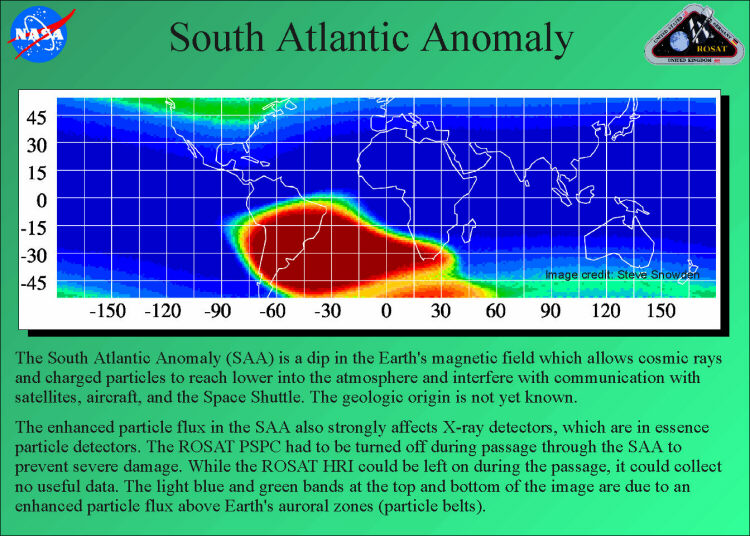Weekly Notes from the Yohkoh Soft X-Ray Telescope
(Week 38, 2002)
Science Nugget: Sept. 20, 2002
Mysterious Anomalies in better detail
What is it?
The South Atlantic Anomaly is a great nuisance for satellites (only those
in low Earth orbit, though) devoted to studying X-rays and gamma-rays from
space -
Yohkoh,
for example, but not
Chandra,
which is in a deep elliptical orbit.
The figure below, with text as ripped off from a
ROSAT
page, explains what it is:
 It is, to be precise, a region of the Earth's magnetic field that is a
little bit weaker, resulting in a superabundance of
Van Allen Belt
particles.
This superabundance is the red blotch in the map above.
Except for an orbit almost exactly equatorial, which is energetically
expensive as a rule, it cannot be avoided and therefore is a terrible
source of background problems for high-energy instruments, since
these particles produce spurious signals in these detectors.
If only the Earth's magnetic field were beautifully symmetric (sigh!) life
would be easier.
As it is, every satellite in low Earth orbit is doomed to fly through the
SAA, as it's known familiarly, every day.
It is, to be precise, a region of the Earth's magnetic field that is a
little bit weaker, resulting in a superabundance of
Van Allen Belt
particles.
This superabundance is the red blotch in the map above.
Except for an orbit almost exactly equatorial, which is energetically
expensive as a rule, it cannot be avoided and therefore is a terrible
source of background problems for high-energy instruments, since
these particles produce spurious signals in these detectors.
If only the Earth's magnetic field were beautifully symmetric (sigh!) life
would be easier.
As it is, every satellite in low Earth orbit is doomed to fly through the
SAA, as it's known familiarly, every day.
What is new?
We now have
RHESSI,
which is (joke) the first huge germanium spectrometer devoted to
magnetospheric research.
The image below, from S"am Krucker's
RHESSI and WIND summary plots,
shows how well it works:
 This needs some explanation.
It is a multi-panel display, and we are only interested in the
next-to-the-bottom panel (click to enlarge).
This is a "dynamic spectrum" display of the RHESSI counting rates.
The vertical dotted lines show orbit night intervals; during the orbit
days one can see a nice solar flare at about 02:25 UT, but also two
dreadful background effects at about 01:00 and about 02:10.
These are not SAA ("The Anomaly") but are anomalous counts nonetheless.
They occur when RHESSI reaches the northernmost (or southernmost) point of
its orbit, and are highly variable in time structure and intensity.
The spectrum shows that it has a maximum in the tens of keV range, unlike
the flare, which peaks at a much lower energy.
This is one of the ways that we recognize the nuisance and ignore it if
possible!
This needs some explanation.
It is a multi-panel display, and we are only interested in the
next-to-the-bottom panel (click to enlarge).
This is a "dynamic spectrum" display of the RHESSI counting rates.
The vertical dotted lines show orbit night intervals; during the orbit
days one can see a nice solar flare at about 02:25 UT, but also two
dreadful background effects at about 01:00 and about 02:10.
These are not SAA ("The Anomaly") but are anomalous counts nonetheless.
They occur when RHESSI reaches the northernmost (or southernmost) point of
its orbit, and are highly variable in time structure and intensity.
The spectrum shows that it has a maximum in the tens of keV range, unlike
the flare, which peaks at a much lower energy.
This is one of the ways that we recognize the nuisance and ignore it if
possible!
Conclusions
These anomalous counts are trapped Van Allen radiation.
With RHESSI we can see it in much better detail than have previous
high-energy astronomy missions (but presumably not better in some ways
than previous magnetospheric missions!).
Perhaps with this better detail we can learn how to anticipate the
background problems that these particles cause, and to compensate for
their presence.
[Topical
index] -o- [Chronological
index]
September 20, 2002
Hugh Hudson hhudson@ssl.berkeley.edu


